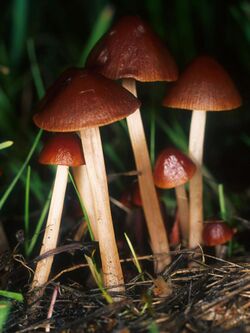Biology:Conocybe
| Conocybe | |
|---|---|

| |
| Conocybe tenera | |
| Scientific classification | |
| Domain: | Eukaryota |
| Kingdom: | Fungi |
| Division: | Basidiomycota |
| Class: | Agaricomycetes |
| Order: | Agaricales |
| Family: | Bolbitiaceae |
| Genus: | Conocybe |
| Type species | |
| Conocybe tenera (Schaeff.) Fayod (1889)
| |
| Synonyms[1] | |
| |
Conocybe is a genus of mushrooms with Conocybe tenera as the type species and at least 243 other species. There are at least 50 different species in North America.
Most have a long, thin fragile stipe and are delicate, growing in grasslands on dead moss, dead grass, sand dunes, decayed wood, and dung. Conocybe species generally prefer fertile soils in lawns and pastures and are found worldwide. Conocybe species are sometimes called dunce caps or cone heads due to their conical or bell-shaped caps. Former species of Conocybe that have a well-developed partial veil and/or lack lecythiform cheilocystidia have been transferred to the genus Pholiotina, which was formerly a subgenus of Conocybe.[2] However, Pholiotina as it is currently defined is polyphyletic, although none of the three clades that make it up belong in Conocybe.[2] Similar to Galerina, a Conocybe species can be distinguished microscopically by its cellular cap cuticle, which is filamentous (thread-like) in Galerina. It is easy to confuse Conocybe species for Galerina species unless the microscopic nature of the cap cuticle is examined. Conocybe species have cap cuticles resembling cobblestones. Conocybe species can also be mistaken for species of Bolbitius.
Four species of Conocybe that are known to contain the hallucinogenic compounds psilocin and psilocybin are C. kuehneriana, C. siligineoides, C. cyanopus, and C. smithii.[3][4] Conocybe siligineoides was used for shamanic purposes by the Mazatecs of Oaxaca.[5]
Conocybe filaris is a common lawn mushroom that contains the same deadly toxins as the death cap.
Conocybe comes from the Greek cono meaning cone and cybe meaning head.
Selected species
- Conocybe apala (very common)
- Conocybe aurea
- Conocybe coprophila (Coprophilous)
- Conocybe cyanopus (psychoactive)
- Conocybe elegans
- Conocybe farinacea (Coprophilous)
- Conocybe filaris (deadly)
- Conocybe kuehneriana (psychoactive)
- Conocybe moseri
- Conocybe pubescens (Coprophilous)
- Conocybe reticulata
- Conocybe rickenii
- Conocybe siligineoides (psychoactive)
- Conocybe smithii (psychoactive)
- Conocybe tenera (type species)
- Conocybe volviradicata[6]
Legal status
United States
Louisiana
Except for ornamental purposes, growing, selling or possessing Conocybe spp. (and Psilocybe spp.) is prohibited by Louisiana State Act 159.
See also
References
- ↑ "Synonymy: Conocybe Fayod". Species Fungorum. CAB International. http://www.speciesfungorum.org/Names/SynSpecies.asp?RecordID=17357.
- ↑ 2.0 2.1 2.2 "Iteratively Refined Guide Trees Help Improving Alignment and Phylogenetic Inference in the Mushroom Family Bolbitiaceae". PLOS ONE 8 (2): e56143. 2013. doi:10.1371/journal.pone.0056143. PMID 23418526. Bibcode: 2013PLoSO...856143T.
- ↑ "A worldwide geographical distribution of the neurotropic fungi, an analysis and discussion". Annali del Museo Civico di Rovereto 14: 198–280. 1998. http://www.magic-mushrooms.net/World_Wide_Distribution_of_Magic_Mushrooms.pdf. Retrieved 2014-08-04.
- ↑ Gotvaldova, Klara; Borovicka, Jan; Hajkova, Katerina; Cihlarova, Petra; Rockefeller, Alan; Kuchar, Martin (2022). "Extensive Collection of Psychotropic Mushrooms with Determination of Their Tryptamine Alkaloids" (in en). International Journal of Molecular Sciences 23 (22): 14068. doi:10.3390/ijms232214068. ISSN 1422-0067.
- ↑ (in fr) Les champignons hallucinogènes du Mexique: études ethnologiques, taxinomiques, biologiques, physiologiques et chimiques. Paris, France: Muséum national d'histoire naturelle. 1958.
- ↑ "Observations on the Bolbitiaceae 31. Conocybe volviradicata sp. nov.". Mycotaxon 114: 145–149. 2010. doi:10.5248/114.145.
External links
| Wikimedia Commons has media related to Conocybe. |
Wikidata ☰ Q1933387 entry
 |

